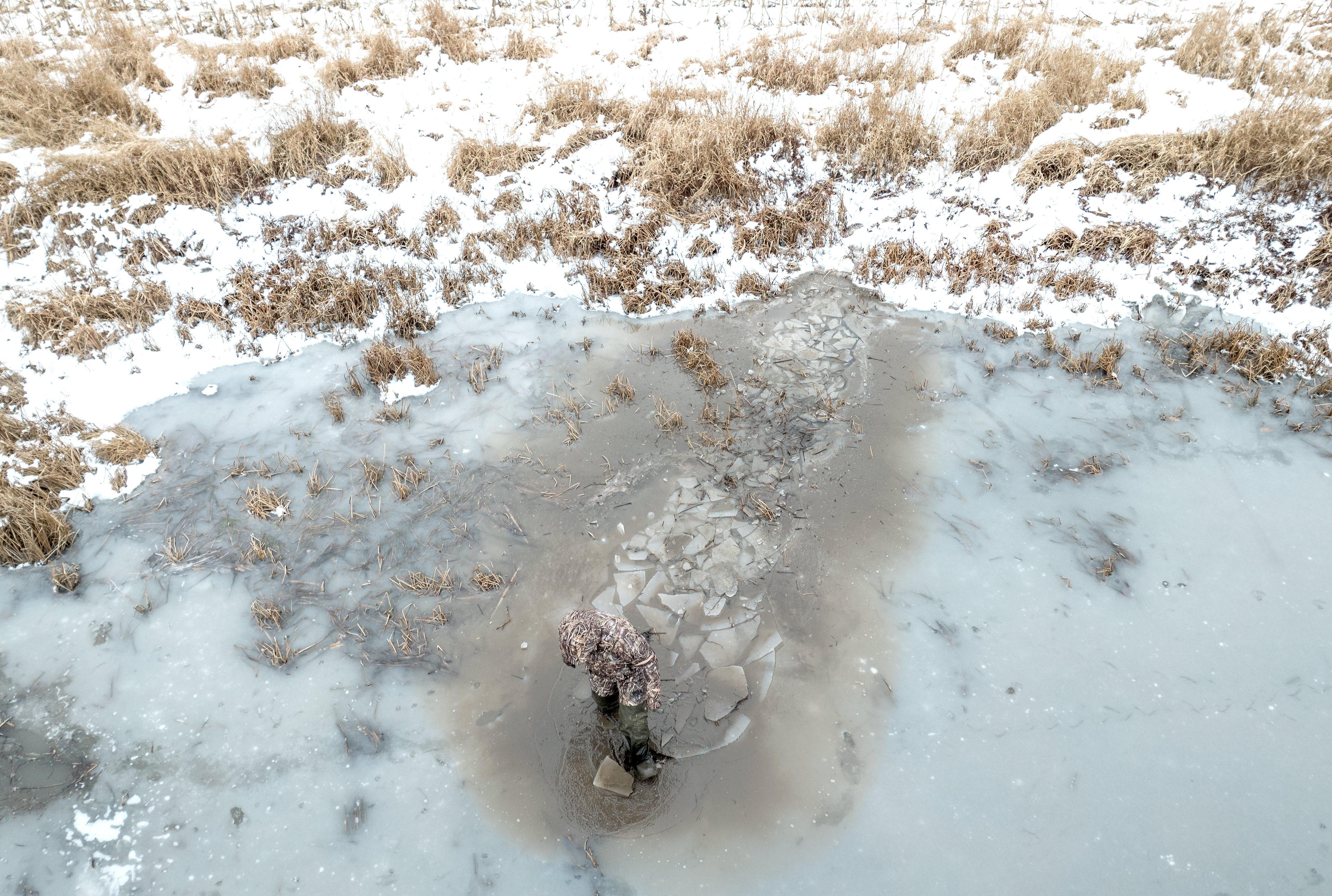Ice can concentrate ducks and create great hunting, but it also presents many challenges. Here’s how to overcome the deep freeze

Hunting over an ice hole can bring fantastic action. Just be extra careful with your gear, your dog, and yourself. Photo by Bill Konway.
The recent cold snap that’s affected much of the country has been a boon for duck hunters, keeping birds moving and creating fresh opportunities. But let’s be honest: Sub-freezing weather brings ice, which can be tricky or even dangerous to deal with. And when you’re on the water or deep into a remote area, no one can bail you out.
So when polar-vortex conditions freeze your duck hole, remember these general rules to have a safe, efficient hunt.
MIND THE DECOYS
Chopping a hole or running an ice-eater can open up frozen areas and let you set water decoys. But remember, the water and air temperatures around those blocks are still extremely cold, so ice might start to form between your fakes and freeze them in place. Assuming it’s safe, regularly break up that skim ice by using a paddle or even walking or boating through the spread.
When it’s sufficiently cold, ice will form on the sides and bills of your decoys, and if enough ice builds up, those blocks will become very heavy. In fact, if the wind is strong enough, your anchor weights might not be enough to hold those ultra-hefty decoys in place, and they can drift into a mess. Watch for that, and don’t let it happen.
Don’t Miss: 6 Reasons Why You’re Not Finishing Ducks
CAREFUL WITH THE DOGS
It’s surprisingly easy for a hunting dog to get hypothermia, and some breeds are more susceptible to it than others. Use common sense when sending your dog on retrieves in icy water — no doubles, triples or 300-yard blinds that might expose Rover to freezing water for too long. After every retrieve, dry off your pup, and make sure it can stay warm, whether in the boat or kennel, or even covered by a blanket. Know the signs of hypothermia in dogs, such as disorientation, violent shivering, shallow breathing, decreased heart rate, and ears and paws that feel cold to the touch. Every one of my retrievers experienced hypothermia at least once, mostly because I was stupid or didn’t realize it soon enough.
Ice also brings more challenges. Sharp, jagged edges can cut a dog if it barrels into the ice. I’m not a big fan of dog vests, but I use them during ice hunts to protect my dog’s chest and sides from getting sliced. In addition, dogs that swim from open water to iced-over shorelines will have a tough time getting atop the ice. Make sure your retriever has a clear, open-water path for every retrieve.
WATERCRAFT SAFETY
Ice can wreck havoc on marine equipment, and if something bad happens to your boat or motor while you’re navigating ice, it can be extremely dangerous. Every aspect of your boat must be up to operating in ice and frigid weather.
First, make sure your hull is sufficiently thick and rugged to break through an inch or more of ice. Many guides run boats with a thicker-than-standard gauge of aluminum for that task. Also, make sure nothing on the outside of your boat can snag or break off on ice. I once came within a whisker of peril when the transducer on the stern of a buddy’s boat broke off in ice, and water filled the hull through the open screw holes.
Be careful with your motor. Make sure it starts reliably in very cold weather. If you run a water-cooled outboard, wait for it to warm up enough that water circulates out of the “pee hole,” indicating that it’s cooling the motor.
Don’t Miss: 3 Times When Duck Hunters Should Pick Up the Spread and Move
WATCH YOURSELF
You can dress for cold weather, but ice demands even more attention. Waterproof decoy gloves will save your hands, and heavy-duty waders — neoprene models or those with extra insulation — can withstand the wear and tear of rubbing against ice.
Use extreme caution when stepping on any potentially icy surface, such as a boat ladder, concrete boat landing or even a shoreline. You can crack your bones pretty easily by falling on rock-hard ice, and it’ll likely be a long boat ride to shore and the emergency room.












